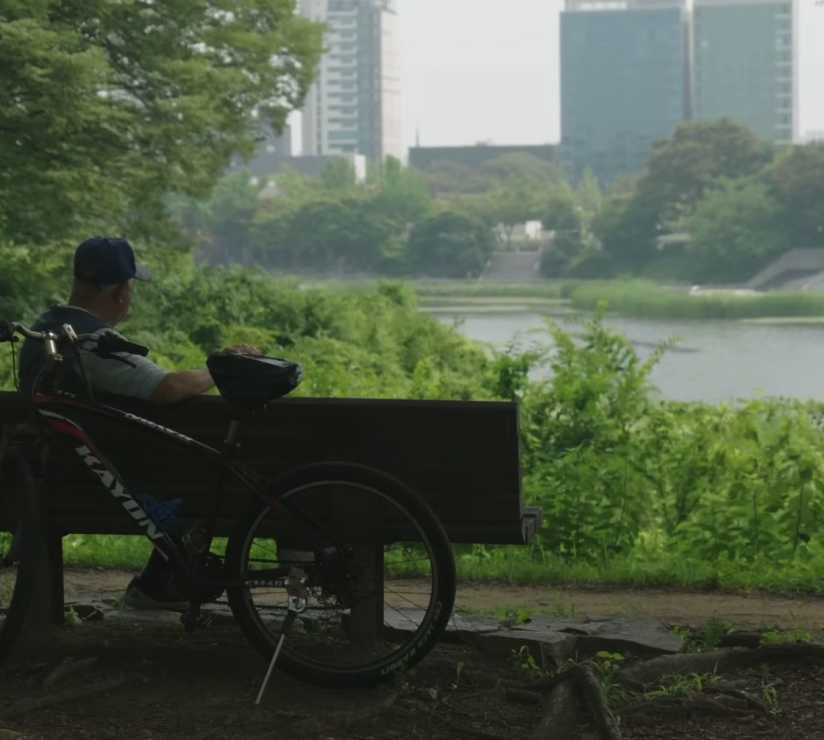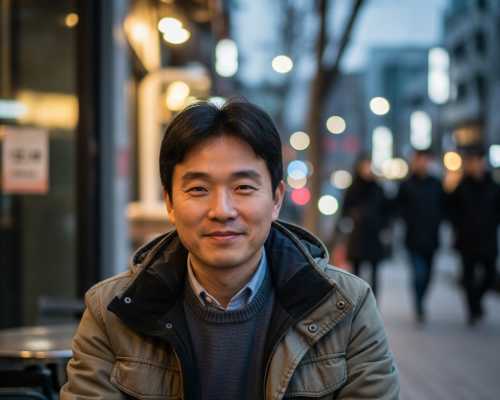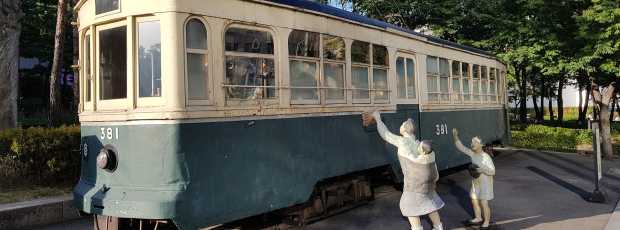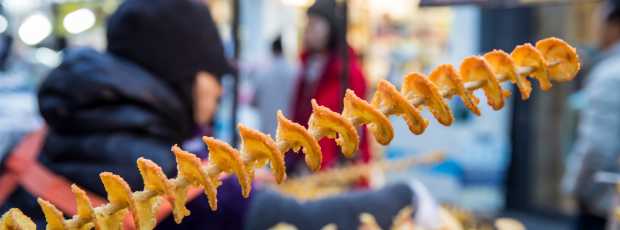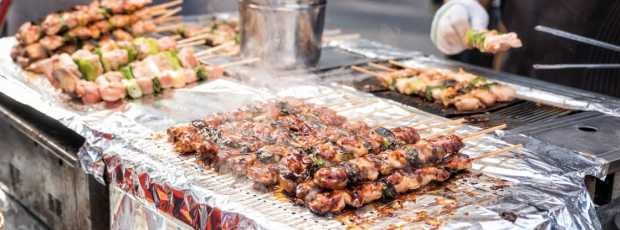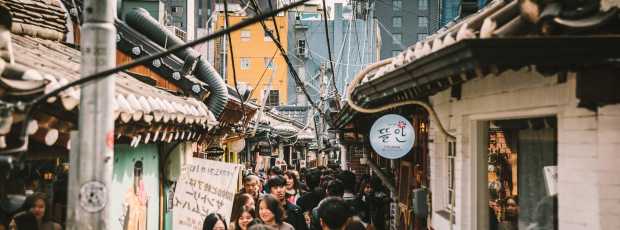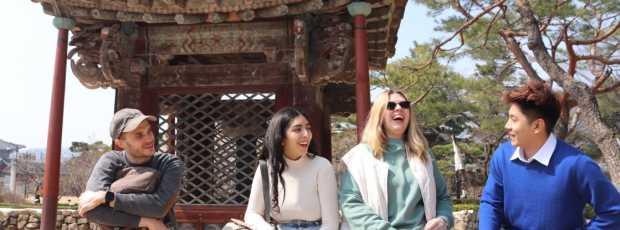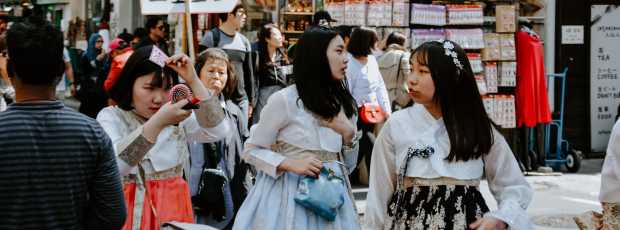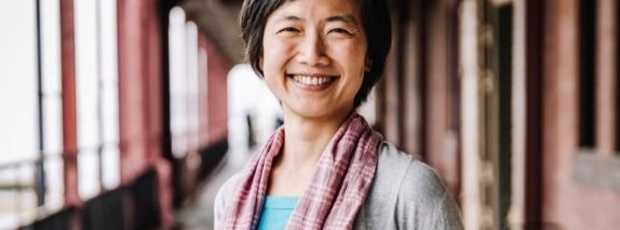We had a private guided tour with guide, Jaen. He was very professional, efficient, and knowledgeable. He made some suggestions that we gladly accepted in order to maximize our sightseeing experience.Dan, Seoul, 2025
Table Of Contents
- Where Are Seoul's Overlooked Historical Treasures?
- Which Local Neighborhoods Show Real Seoul Life?
- Where Do Locals Really Eat in Seoul?
- Which Seoul Markets Feel Truly Local?
- What Green Spaces Do Locals Escape To?
- What Are Seoul's Most Unique Local Experiences?
- Where Can I Shop Like a Local?
- Which Cultural Spots Do Travelers Miss?
- Overrated vs Real: Where Seoul Goes
- Practical Tips for Finding Seoul's Hidden Side
- Frequently Asked Questions
- Finding Seoul's Soul
While tourists cluster around Myeongdong and Hongdae, South Korea an Seoul's lesser-known spots wait quietly in forgotten corners. Some remain genuinely off the radar, while others have gained attention but still reward visitors who time their trip right.
These non-touristy spots don't call attention to themselves with flashy signs or English menus. Instead, they offer genuine encounters that feel like quiet exchanges between locals.
I'm Hyunwoo Jang and moved to Seoul six years ago to document traditional architecture but got pulled into the neighborhoods instead. Understanding Seoul's hidden side means seeing the city in a whole new way.
Most mornings, I walk through markets before the tourist buses arrive, chat with vendors who've worked the same stalls for thirty years, and watch the city wake up.
I will show you the neighborhoods, flavors, and hidden corners that still carry the city's original energy and makes for the best Seoul experiences.

Dawn light over converted filtration tanks at Seonyudo Park
Where Are Seoul's Overlooked Historical Treasures?
The real hidden gems often sit quietly in plain sight. These architectural details and lesser-known sites offer a deeper connection to Korean culture than many of the more popular tourist spots in South Korea.
Seonyudo Park: Urban Renewal on the Han River
Seonyudo Park transforms a former water treatment plant into one of Seoul's most unexpected green spaces. Set on a small island in the Han River, industrial structures blend with curated gardens and pockets of native plants. Repurposed facilities are used for gardens and small exhibits. Elevated walkways offer stunning views across the water and back toward the city center.
The park shifts with every season. Cherry blossoms frame the old brick structures in spring, while autumn brings rust-colored foliage that mirrors the industrial bones beneath. While locals know this spot well, it stays calmer than headline Han River parks, especially on weekday mornings. Locals use the space for yoga at sunrise or quiet reading in the shade of willows planted where chemicals once flowed. Arrive before 9 AM to experience the industrial-heritage atmosphere without the crowds.
Choose Seonyudo Park over Yeouido Hangang Park when you want ecological beauty and industrial history instead of crowded riverside bike paths.
Bugaksan Fortress Trail: Ancient Walls and Sunrise Views
The Bugaksan Fortress Trail is one of the city's most rewarding hikes, now open without advance reservation as part of the Seoul City Wall Trail. While no longer obscure, it stays far quieter than the tourist buses that crowd Namsan and Seoul Tower, especially at sunrise or on weekday mornings.
The climb takes effort, about ninety minutes at a steady pace, but the reward is worth it. Sunrise from the summit gives a quiet, wide-angle view of South Korea's transformation, stretching from the mountains in the north to the city center below. I once shared my thermos of coffee with a retired teacher who hikes here every Tuesday morning. He told me he's watched the skyline change from this exact spot for forty years, one skyscraper at a time. Start before 6:30 AM to beat both the crowds and the afternoon heat.
Seodaemun Prison History Hall: Korea's Darkest Chapter Preserved
Seodaemun Prison History Hall in Seodaemun-gu brings visitors face-to-face with one of Korea's most painful colonial chapters. This former Japanese prison, where independence fighters were imprisoned, tortured, and executed, preserves difficult truths about occupation and resistance. Walking through its original cells and execution chambers offers a quiet but powerful insight into Korean history that no textbook can fully express.
The narrow corridors still carry weight. During my first visit, I stood in the underground torture chamber longer than I meant to. A guide explained that some of the independence activists held here were barely older than college students today. The experience lingers, reshaping how many understand modern Korea.
These historical sites matter because they ground Seoul's modern energy in the struggles that made it possible.
Experiences Created by Locals, Just for You
See the city through the eyes of the people who call it home.

The old meeting the new with bars and printing shops in Euljiro
Which Local Neighborhoods Show Real Seoul Life?
Tourist maps often overlook the local neighborhoods in Seoul where daily life quietly unfolds. These offbeat areas reveal the city's genuine character through residential streets, family-run businesses, and community spaces shaped over generations. Locals move through them with ease and familiarity, creating underrated places that feel far removed from crowded attractions.
Why Choose Euljiro for Nightlife?
Because after dark, the printing alleys flip into intimate bars that still feel more local than polished. By day, Euljiro is a working printing district where elderly craftsmen still operate decades-old machines that once produced Seoul's newspapers. After dark, the same alleys shift in character, drawing creative locals to hidden bars and gathering spots.
The neighborhood's "Hipjiro" nightlife scene has gained attention in recent years, but weeknight visits (Monday through Thursday) still offer a more authentic experience than weekend crowds. Walls here function as open-air galleries, layered with expression that changes week to week. Small stationery shops tucked between printing houses stock handmade paper, imported pens, and specialty notebooks that artists covet. Skip the most Instagrammed bars and wander side streets to find spots where the owner recognizes regulars.
Where Can You See Everyday Hanok Life Without Crowds?
Seochon, just west of Gyeongbokgung Palace, offers quiet alleys and small craft shops where daily life continues at its own pace. Mornings reveal residents tending plants or hanging laundry outside hanok homes, scenes that reflect a slower rhythm many tourist areas have lost.
This neighborhood holds onto tradition without performance. Indie bookstores, cafés, and workshops welcome locals, not crowds. The lack of signage and tour groups means you discover each corner on your own terms, often stumbling onto courtyard gardens or family-run tea rooms that feel like neighborhood secrets.
Go Beyond the Seoul Checklist
Discover the city guidebooks don’t cover with a local by your side.
What Makes Yeonnam-dong Worth Visiting?
Yeonnam-dong and the Gyeongui Line Forest Park have become popular weekend destinations in recent years, drawing crowds to its leafy streets and indie cafés. The neighborhood still offers village-like charm, but visit on weekday mornings (before 11 AM) to experience it before the brunch rush arrives.
Many of the area's hanok homes have been converted into art studios, vintage shops, and intimate restaurants that thrive on word-of-mouth rather than online buzz. Cool galleries often occupy the upper floors, while the first floors hold coffee shops and boutiques. Early weekday visits let you browse without the shoulder-to-shoulder crowds that now pack the streets on Saturdays and Sundays.
Mullae: Where Industry Meets Art
Step into Mullae and you'll find industrial grit colliding with creative energy in a way that feels surprisingly organic. Metal workshops share buildings with artist studios, forming a neighborhood where traditional craftsmen work side by side with contemporary creators.
Once, I stepped into a studio thinking it was a café. They gave me tea anyway, and an impromptu crash course in metal sculpture. The smell of metal mixes with the aroma of fresh coffee from hole-in-the-wall roasters. Visit in the late afternoon to catch the area's rhythm as both worlds start to wind down. Nearly every wall is a canvas, covered in street art that nods to Mullae's working-class roots and creative future.
Pick Mullae over Insadong's tourist galleries because here you meet the artists in their actual working spaces, not salespeople in gift shops.
Unlike Japan's structured nightlife districts, evenings here unfold naturally.
Gyeongnidan: Hilltop Views and Seoul's Laid-Back Side
Gyeongnidan offers a quieter take on Itaewon's global buzz. This hillside neighborhood draws people with its low-key bars, international eateries, great music, and rooftop views across the city.
Winding alleys reveal family-run restaurants serving regional Korean dishes, tucked beside small venues where musicians and artists perform for intimate crowds. Unlike Japan's structured nightlife districts, evenings here unfold naturally, with locals moving between spots in a way that feels spontaneous and social.
These best neighborhoods in Seoul reveal the city's genuine character, though timing matters more than ever as Seoul's creative districts gain international attention.
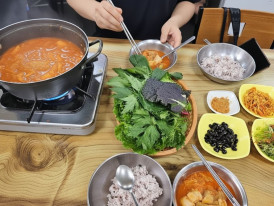
Steaming bowls of kimchi jjigae with full banchan spread
Where Do Locals Really Eat in Seoul?
The best hidden restaurants do not advertise or cater to tourists, but those who know what to eat in Seoul are very familiar with them. These local food spots rely on familiarity, patience, and the kind of communication that happens without words. Many reflect traditional Korean culture through recipes passed down quietly over generations.
A Samcheong-dong Spot Locals Trust for Samgyetang
In quiet neighborhoods across Seoul, samgyetang specialists serve a single dish refined over decades.
One I keep going back to is Grandma's Hand-Cut Noodles (할머니 손칼국수) in Samcheong-dong. It's tucked in a back alley and better known for its kalguksu, but the home-style ginseng chicken soup is the kind locals trust.
To me, this place is a food paradise, worth more than a mere glimpse. The broth simmers for hours, with a depth you rarely find in bigger restaurants. There are no glossy menus here, just hearty flavors that feel like they came from someone's own kitchen.
Hungry to Try Seoul's Food Yourself?
Taste and explore the flavors locals actually love.
Gwangjang's Lesser-Known Street Food Legends
Beyond the main entrance and bright signage, Gwangjang Market opens into a warren of back alleys where old-school food stalls still serve locals every day. The market has become hugely popular with visitors in recent years, so arrive before 11 AM or after 2 PM on weekdays to avoid peak lunch crowds and tour groups.
Venture deeper and you might find Inhyeon Market Gopchang Hot Pot (인현시장 곱창전골) near the Euljiro printing district. The gopchang hot pot here is gritty, loud, and unforgettable, the kind of meal that leaves your clothes smelling like the kitchen in the best way.
Regulars return weekly and are often greeted like family before they have even sat down, the smell of sizzling batter and garlic pulling you in long before you see the stall. Last spring, the owner recognized me from a single visit months earlier and immediately started prepping my usual order without asking. The front-row bindaetteok and mayak gimbap stalls draw lines, but walk to the market's outer edges for similar quality without the wait.
Gwangjang has also become a popular K drama filming location, with scenes appearing in multiple series over the years. If you recognize the market from Korean dramas, you're not alone. K dramas have introduced these food alleys to international audiences, though the authenticity remains if you visit at the right times.
Want To Taste Seoul's Street Food?
A local can show you the best spots for amazing street food.
Seoul's Best Kimchi Jjigae Is Upstairs or Downstairs
In Mapo, Seongbuk-dong, and Buam-dong, basement diners and second-floor restaurants serve what many still consider the ultimate comfort food, kimchi jjigae. My favorite is Yeonnam Hand-Cut Noodles (연남 손칼국수) in a quiet residential lane. Their homemade jjigae has a deep, tangy spice that tastes like it has been perfected over decades. On weekends, they also make sujebi, or hand-pulled dough soup, which is just as good and a local secret worth knowing.
Where Do Seoulites Drink and Unwind After Dark?
Nonhyeon and Sangsu shift after sunset, when pojangmacha and tiny bars take over quiet corners. One spot that stays with me is Haebangmandu (해방 만두) in Haebangchon. It is not technically a tent, but it has the same unpolished charm. Just a handful of stools, handmade dumplings, and a third-generation owner who treats you like you have been coming for years.
One rainy Tuesday, I ducked in soaking wet and was handed a towel before I even ordered. The owner's grandmother, who still rolls dumplings in the back, sent out an extra plate with a nod. Grab a beer, settle in, and enjoy the kind of place where everyone keeps to themselves until they do not.
These hidden restaurants rely on familiarity and recipes passed down quietly over generations, creating connections that feel genuine rather than transactional.
Plant-Based Korean Food With Deep Roots
In Insadong, tucked-away restaurants serve vegan temple cuisine rooted in Buddhist tradition. I always return to Sanchon (산촌), a peaceful spot down a narrow alley near Insadong-gil. Founded by a former monk, it is a place where time seems to slow, with low tables, soft music, and a meal that changes with the seasons. The lotus root and wild greens are standouts, lingering in your memory long after you have left.
Imagine Having a Friend in Every City
Our locals share their city with you the way they live it: flexible, real, and unscripted.
See how it works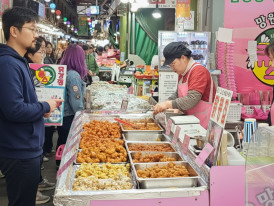
Mangwon Market
Which Seoul Markets Feel Truly Local?
Seoul's food streets and non-touristy markets, frequented daily by locals, offer authentic culinary experiences that reveal the city's genuine food culture through neighborhood specialties and time-honored traditions. Wanna know what things to do with those few extra hours you have? This is it.
Build-Your-Own Lunchbox at Tongin Market
Tongin Market near Gyeongbokgung Palace offers a hands-on dosirak (lunchbox) experience. Visitors use brass coins to collect banchan and rice from a variety of vendors, building a meal one dish at a time. The market supports local families and small food businesses, each known for doing one thing well. It's a satisfying stop for food lovers looking beyond the typical tourist scene.
The Serious Carnivore's Stop: Majang Meat Market
Majang Meat Market is where BBQ experts and restaurant owners go for the best cuts, remaining largely off the tourist circuit. This wholesale hub is all about meat quality, not atmosphere. Restaurants nearby serve generous portions of aged beef and pork at local prices, with no frills and no distractions.
Floor after floor of vendors makes it a maze that rewards patient exploration. You'll hear butchers calling out in Korean, see professionals inspecting marbling, and likely be the only foreigner on your floor. It's a working market first, a dining destination second, which is precisely why it stays authentic.
Because No Two Travelers Are the Same
We help you shape a city day that matches your pace, your style, and your curiosity, not a fixed route.Mangwon Market: Everyday Flavor in Mapo
Mangwon Market is the Mapo district's go-to spot for fresh produce, handmade meals, and everyday goods. While foodies have started paying attention, it still feels grounded in local routines. The prepared food stalls serve up a variety at fair prices, giving visitors a real taste of neighborhood Seoul.
Choose Mangwon over Gwangjang Market when you want to shop where actual neighborhood families buy their weekly groceries, not just eat street food.
What Makes Gyeongdong Market Special?
Gyeongdong Market in Dongdaemun-gu specializes in traditional Korean medicine and dried goods, remaining genuinely off most tourist radars. Families have followed its rhythms for generations. Vendors here know their ingredients well, often handing down knowledge through the family line. The atmosphere is practical and calm, focused on healing foods and daily staples.
I've watched herbalists blend custom tea mixes while explaining each root's purpose, a level of care that feels increasingly rare. Tourist traffic here stays modest compared to Gwangjang, making it one of the few markets where you'll hear more Korean than English on any given day. Aisles of dried fish, medicinal roots, and bulk grains reveal Seoul's traditional food culture without performance or Instagram posing.
Sindang Tteokbokki Alley: Seoul's Spicy Side
Tucked into a small hill in Sindang-dong, this alley brings together Seoul's top tteokbokki vendors. Each stall offers a unique recipe and spice level, drawing locals who return week after week. Whether you're a heat seeker or a comfort food fan, this strip of spicy rice cake specialists has something for you.
Seoul's traditional markets range from hidden gems to popular destinations, but even the well-known ones reward early-morning or off-peak visits when local rhythms take precedence over tourist traffic.
Curious What You Won’t Find Online About Seoul's Markets?
Discover the side only locals talk about.

Families and people along Seoul Forest's tree-lined paths
What Green Spaces Do Locals Escape To?
Some of Seoul's quietest parks stay off the radar, even for return visitors. These lesser-known green spaces give locals and travelers a break from the city's nonstop energy. They're places to slow down, notice the seasons, and take in nature without leaving town.
Seoul Forest Blends Nature and Urban Life
Seoul Forest isn't just a park. It's a breath of air in the middle of the capital. Open meadows, wooded trails, and deer enclosures give the area range and rhythm. Birdwatchers, dog-walkers, and early joggers each find their corner. It's a natural pause that still feels connected to the city around it.
Pick Seoul Forest over the crowded paths at Namsan when you want space to spread out a picnic blanket without claiming territory.
Achasan: Sunrise Trails and Local Stillness
Achasan might not top most guidebooks, but locals know it as a peaceful hike with wide views over Seoul. The main trail is easy to moderate, making it a favorite for early morning walkers, families, and seniors. Sunrise is the best time to go. The light over the Han River and city skyline is soft and slow, and the path stays quiet, especially on weekdays.
There's no need for special gear or a long commute. Achasan Station on Line 5 gets you close to the trailhead, and the walk itself takes less than an hour to reach the top. Friendly hikers often greet one another with a quiet nod, and benches along the way let you pause and take it all in.
While well-known spots like Bukchon Hanok Village attract bigger crowds, Achasan offers something more personal. You don't need a tour or itinerary here, just a thermos of coffee and a little time. From the summit, the city feels calm and close, its bridges stretching across the Han River like ribbons in the morning light.
Want to Experience Hiking in Seoul Firsthand?
Step into the neighborhood, scene, or story with someone who knows it inside out.
Haneul Park: Skyline Sunsets and Silver Grass
Haneul Park, once a landfill, draws locals for golden-hour skyline views and seasonal grasslands. Silver grass sways in autumn, wildflowers bloom in spring, and snow softens the fields in winter. Elevated trails lead to sweeping views that rival those from more famous observation decks.
Fair warning: avoid October if you want solitude. The Silver Grass Festival brings evening light shows, performances, and massive crowds that turn this into one of Seoul's busiest fall destinations. Visit in early November after the festival ends, or come in spring or winter when the park returns to its quieter rhythm.
Can I Find Sunrise Views Away from Crowds?
Naksan Park offers an easy climb and some of the best sunrise views in Seoul. While it's become a known sunrise spot among locals, arriving before 6 AM on weekdays still offers relative solitude. From the top, you'll see the eastern skyline and the Han River valley open up in front of you. The trail follows sections of the old fortress wall, with quiet lookout points along the way that are ideal for early morning walks and photos.
The walk up takes only twenty minutes from street level, making it more accessible than steeper mountain trails. Locals favor this spot for catching first light over Dongdaemun and the river's eastern bend, a different angle than most observation points offer.
Nearby Ihwa Mural Village adds color to the walk, though it appears on many Seoul itineraries now. Some murals were removed after resident complaints about noise and disrespect from visitors. Go before 8 AM if you want to see the remaining artwork without the Instagram crowds, or skip it entirely out of respect for the neighborhood's residents.
Seoul Iris Garden: A Seasonal Spectacle
In late spring, the Seoul Iris Garden in Dobong-gu turns into a natural painting that most first-time visitors never discover. Thousands of blooming irises cover the wetland landscape, drawing photographers and plant lovers who know about this seasonal gem. The layout blends traditional Korean landscaping with native ecology.
The garden sits far from central tourist districts, which keeps crowds manageable even during peak bloom in late May and early June. Visit during peak bloom for the full effect, ideally on a weekday morning when you might share the boardwalks with just a handful of serious photography enthusiasts and elderly locals.
The garden's remote location in Dobong-gu means it requires deliberate planning to visit. It won't appear on most Seoul location guides or automated itineraries. That distance from central tourist areas is precisely what keeps it a great place for nature photography and quiet reflection, far from the crowds that pack more accessible parks.
Doseonsa Temple: Mountain Calm, No Hike Required
Doseonsa Temple rests at the base of Bukhansan, offering a peaceful retreat without the uphill trek that tour buses can't reach. Classic temple buildings, quiet gardens, and occasional cultural events make it a good spot for reflection. The walk from Anguk Station takes about twenty minutes through residential streets, offering a gradual transition from city noise to temple stillness.
This foothill temple sees far fewer visitors than central temples like Jogyesa or Bongeunsa, making it one of the rare spots where you can experience Korean Buddhist temple culture in relative solitude on any day of the week.
Choose Doseonsa over Jogyesa Temple because you'll experience temple culture in a quieter mountain setting instead of surrounded by Insadong's tourist traffic.
These quiet green spaces let locals escape the city's intensity without leaving town, though some now require strategic timing to experience them at their most peaceful.
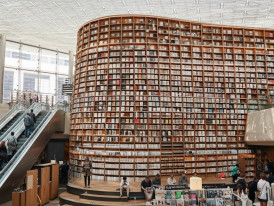
Multi-level bookstore interior with floor-to-ceiling shelves and Korean readers
What Are Seoul's Most Unique Local Experiences?
The city's offbeat side comes alive in places locals go to relax, play, and get a little weird in the best way. These lesser-known spots are just a stone's throw from traditional landmarks like Gyeongbokgung Palace, revealing how layered Seoul's personality really is.
VR Cafes in Sinchon: High-end headsets, multiplayer games, and digital escape without leaving the city.
Coin Karaoke Booths: Tiny soundproof rooms where locals belt out ballads solo or with friends for just a few bucks.
Picnics & Bike Rentals: Rent a bike, grab beer and snacks, and cruise riverside paths at sunset. A summer ritual, unlocked.
Doksan Dog Café: Coffee, cuddles, and canine chaos in one of the most beloved pet cafés around.
Thanks Nature Café: Near Hongdae's university campus, this quirky below-ground spot lets you sip coffee alongside two resident sheep. Wooden furniture and a laid-back vibe make the unusual pairing somehow work.
Nuldam Space: This vegan café near Gyeongbok Palace invites guests to write letters to their future selves, which the café holds and mails months later. Spread across three calm floors, the menu includes indulgent treats like peanut cream croffles, buttery and nutty without the weight.
Drunken Bean: Tucked into a quiet Gangnam backstreet, this café recreates a New York subway car with tiled walls, industrial lighting, metal turnstiles, and a full replica subway car along the back wall. Locals fill the tables, a reliable sign the coffee is solid.
Cheongun Book Alley: Indie bookstores and literary cafés tucked into a quiet hillside. A low-key haven for readers and writers from everywhere in the world.
Kyobo Book Centre Gwanghwamun: In the heart of Jongno, this massive bookstore reflects Korea's enduring love for print. Multiple floors hold everything from bestsellers to rare imports, and the café upstairs offers a quiet corner to read.
These offbeat experiences show Seoul's playful, creative side, the perfect counterpoint to temple trips and palace tours. For more of Seoul at night, pojangmacha districts and late-night markets reveal a different energy entirely.
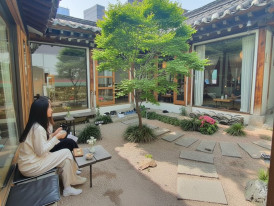
Traditional hanok tea house courtyard in Ikseon-dong
Where Can I Shop Like a Local?
Independent boutiques and lesser-known shopping areas offer authentic retail experiences that support local creators, traditional craftspeople, and vintage collectors. These underrated spots often hold unique finds tucked into historic alleyways or quiet, village-style neighborhoods.
Vintage Treasure-Hunting at Dongmyo Flea Market
Dongmyo Flea Market offers Seoul's most authentic vintage shopping experience. Vendors specialize in genuinely aged clothing, accessories, and household goods, not mass-produced "vintage-style" items. The weekend crowd includes collectors, fashion students, and locals looking for pieces that reflect Korea's evolving material culture. Bargaining is expected, and many vendors have worked the same stalls for decades. Multiple vendor levels reward curious browsers.
Artisan Boutiques in Ikseon-dong Hanok Village
Ikseon-dong boutiques and studios fill restored buildings in Ikseon-dong Hanok Village. Independent artisans sell handmade ceramics, textiles, jewelry, and home goods that blend traditional Korean techniques with modern design. The neighborhood is easy to explore on foot, and many creators sell their work in the same spaces where they make it. It's common to find shops on the first floor and working studios just upstairs.
Hidden Hanok Tea Houses in Ikseon-dong
Tucked inside Ikseon-dong's hanok alleys, hidden tea houses offer a quiet retreat that many tourists miss. Some blend traditional architecture with seasonal gardens, koi ponds, or flowering courtyards. A few serve tea in the classical Korean style, while others bring a modern edge with handmade ceramics or updated flavors. Even on busy weekends, these spots remain calm, just a short walk from the neighborhood's livelier cafés and shops.
For lunch, Songam Onban (송암온반) pairs traditional hanok design with a peaceful inner garden. Order via touchscreen at your table and try the pork rice soup, seafood pancakes, or perilla oil noodles. The blend of old architecture and modern convenience makes it a satisfying midday pause.
Seoul's Artisan Goods and Creative Workshops
Stationery in Euljiro: Euljiro's stationery shops serve artists, students, and professionals who value well-made tools. These compact stores stock paper goods, sketchbooks, and niche supplies that reflect Korea's deep stationery culture. There's a care and depth here that online shopping just can't replicate.
Creative Retail and Workshops in Mullae: Mullae's studios blur the line between shop and studio. You'll find local ceramics, textiles, and prints alongside hands-on classes where visitors can try their hand at making something. These spaces feel more like creative hubs than stores, encouraging both browsing and conversation.
These independent shopping spots support local artisans and offer finds you won't see anywhere else, making them essential stops on any hidden gems experience.
Imagine Experiencing Seoul for Real
A local can show you the vibe, flavors, and hidden gems up close.

Multi-story vertical garden inside Seoul City Hall
Which Cultural Spots Do Travelers Miss?
Seoul's cultural landscape extends well beyond the palace circuit. These creative and historical spaces offer fresh perspectives on the city's past and future.
Oil Tank Culture Park: Art in Unexpected Spaces
What began as an oil storage depot has become one of Seoul's more inventive cultural venues. The repurposed tanks now host rotating art installations, outdoor concerts, and community events that draw a mix of local families and creative types. Wander through and you'll see how industrial infrastructure can take on new life. The space challenges assumptions about what belongs in a park and what deserves preservation.
Changgyeonggung Palace: Quiet Royalty
Just a short walk from Insadong, Changgyeonggung Palace offers the grandeur of Seoul's better-known royal sites without the crowds. The grounds stay peaceful even on weekends, and the traditional architecture rewards slow exploration. It's an easy addition to an Ikseon-dong afternoon.
Bukchang-dong: A Practical Base Near the Action
Most tourists skip Bukchang-dong entirely, drawn instead to the flashier energy of Myeongdong or Insadong. That oversight makes this central neighborhood a practical, budget-friendly base that remains genuinely off the tourist radar. Namdaemun Market sits at its heart, Korea's oldest and largest traditional market, where vendors sell everything from fresh produce to vintage cameras across hundreds of stalls.
Three lesser-known spots make Bukchang-dong worth exploring on foot. Jeongdong Observatory offers free city views from the 13th floor of an office building that most tourists never discover, looking down on Deoksugung Palace and out toward Gyeongbokgung and the mountains beyond (open weekdays 1:30 PM to 5:30 PM, weekends 9 AM to 5:30 PM).
Inside Seoul City Hall, a multi-story vertical garden brings an unexpected green pause to the modern interior. Seoullo 7017, a park built on a former highway overpass, lets you walk between skyscrapers at eye level, literally threading through the city above the streets.
The neighborhood comes alive at lunchtime when office workers flood local restaurants, then again in the evening when pojangmacha tents pop up. It's Seoul as Seoulites live it, not a curated experience, and one of the few central areas where budget accommodations outnumber luxury hotels.
These cultural and historical spaces reveal layers of Seoul's identity that popular palace circuits miss, and when you've exhausted the city's hidden corners, day trips from Seoul to nearby mountain temples, coastal towns, and traditional villages extend the exploration beyond city limits.
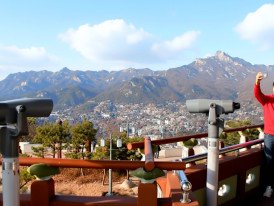
Bugaksan Skyway Palgakjeong
Overrated vs Real: Where Seoul Goes
Tourist magnets often overshadow quieter alternatives that offer more authentic experiences. Here's where to redirect your time for a local perspective.
N Seoul Tower Observation Deck → Bugaksan Skyway Palgakjeong
Skip the crowded cable car and souvenir-locked fences. Head to Palgakjeong pavilion on the Bugaksan trail instead. You'll get equally stunning city views without the queues, plus the satisfaction of earning your vista with a moderate hike. Go at sunrise when the trail stays quiet and the light turns golden.
Myeongdong Street Food → Gyeongdong Market
Myeongdong's food stalls cater to tour groups with inflated prices and predictable menus. For authentic market energy that tourists rarely discover, explore Gyeongdong Market's traditional vendors instead, where medicinal foods and family recipes remain rooted in genuine local culture.
Insadong Souvenir Shops → Ikseon-dong Artisan Studios
Mass-produced trinkets fill Insadong's main drag, but Ikseon-dong Hanok Village offers handmade ceramics, textiles, and jewelry from independent creators working in the same spaces where they sell. You'll find pieces with actual stories, often meeting the artists who made them on the floors above the shop.
Imagine Experiencing Insadong's Souvenir Shops for Real
A local can show you the vibe, flavors, and hidden gems up close.
Bukchon Hanok Village Photo Ops → Seochon Residential Alleys
Bukchon draws endless crowds snapping the same uphill shot while residents post "quiet please" signs. Seochon, just west of Gyeongbokgung Palace, offers similar hanok architecture with working neighborhoods intact. Plan your trip for weekday mornings when locals hang laundry and tend gardens, and you'll see traditional homes as living spaces, not backdrops.
Gangnam Club District → Euljiro After-Dark Bars
Gangnam's clubs pack tourists and inflated drink prices into polished spaces designed for Instagram. Euljiro's hidden bars occupy former printing shops and warehouse corners, drawing creative locals with atmosphere over flash. The drinks cost half as much, and conversations happen naturally when everyone's squeezed into a ten-person basement bar.
Redirecting from tourist magnets to local alternatives gives you authentic experiences and better value, while supporting neighborhoods that thrive on genuine community rather than tour-bus traffic.
Practical Tips for Finding Seoul's Hidden Side
Getting There: Most neighborhoods connect via Seoul's efficient subway system. Download the Kakao Metro app for real-time directions. Buses reach farther but require more Korean language comfort. Walking between adjacent areas like Ikseon-dong and Insadong takes ten minutes and reveals street-level details you'd miss underground.
Best Times: Early morning (6 AM to 8 AM) and late evening (after 8 PM) offer the most authentic experiences. Markets bustle before tourist hours, trails stay peaceful at sunrise, and neighborhoods shift character after dark when pojangmacha tents open. Weekdays beat weekends for crowd-sensitive spots like Bukchon or Ihwa Mural Village.
Step-Free Access: Many hanok neighborhoods, hiking trails, and basement restaurants involve stairs. Seoul Forest, Seonyudo Park, and Haneul Park offer flat, accessible paths. Markets vary, with Mangwon and Tongin mostly level, while others have multiple floors connected by stairs.
Rain Plans: Seoul's indoor culture thrives year-round. Redirect wet days toward museums, VR cafés, underground shopping streets like Gangnam's COEX Mall, or multi-story bookstores. Covered markets like Gwangjang stay dry while maintaining their energy.
Basic Etiquette: Pour drinks for others, never yourself. Share dishes family-style rather than ordering individually. Remove shoes before entering homes, some restaurants, and all temples. Greet elders with a slight bow. In markets, vendors appreciate a smile and basic Korean phrases (안녕하세요 for hello, 감사합니다 for thank you) more than perfect pronunciation.
Language Navigation: Many neighborhood spots operate in Korean only. Screenshot names in Hangul before you go, and the Papago translation app works offline. Pointing at dishes other customers are eating and holding up fingers for quantity works everywhere. Locals respond warmly to sincere attempts, even broken ones. Many neighborhood spots don't appear on Google Maps in English, so use Naver Map or Kakao Map for your location search. These Korean platforms offer better accuracy for small alleys and side-street businesses. Search by the Korean name (Hangul) rather than romanization for the most reliable results, and save key locations offline before you head out.
With a Local Guide: City Unscripted connects visitors with Seoul residents who know their neighborhoods inside out. A local host can navigate Korean-only menus, explain market etiquette, and adjust timing to avoid crowds. They'll also share the kind of micro-details (which banchan to try first, why certain streets flood in summer) that only come from living here.
Before You Go, Talk to Someone Who Knows
A local video call helps you plan the trip that’s right for you.
Frequently Asked Questions
1) What are Seoul's best hidden gems?
Seoul's best hidden gems include Seonyudo Park's industrial-turned-natural retreat, Euljiro's gritty nightlife, traditional markets like Tongin and Mangwon, and peaceful temple spots like Doseonsa. Gyeongdong Market reflects Korea's traditional medicine culture, while Ihwa Mural Village offers street art with a local voice. These underrated places reveal Seoul's character in ways the usual tourist stops can't. Space them out across trips to really take in the city's depth.
2) What's something only locals know to do in Seoul?
Locals move through the city by rhythm, not schedule. They watch sunrise from Naksan Park, eat kimchi jjigae in basement diners at midnight, or wander through Mullae's quiet galleries while the city sleeps. It's less about planning and more about feeling. That's when Seoul feels most real.
3) What's a non-touristy thing to do in Seoul?
Try making your own dosirak at Tongin Market, hiking the uncrowded Bugaksan trail, exploring VR cafes in university areas, visiting working artists' studios in Mullae, or joining locals for riverside picnics during golden hour. Head to Cheonggyecheon Stream for evening walks, look for creative murals in quiet neighborhoods, or take pictures at hidden viewpoints that locals hope tourists never discover.
4) Are there quiet places in Seoul?
Absolutely. Doseonsa Temple offers spiritual calm without the uphill trek. Haneul Park's sweeping grasslands glow at sunset. Seoul Iris Garden bursts into bloom in spring. Small parks, quiet tea houses, and temples tucked inside residential areas give Seoulites peaceful places to recharge.
5) What food in Seoul do tourists miss?
Most tourists skip grandmother-run kimchi jjigae diners, temple cuisine restaurants, and back-alley pojangmacha stalls. At Gwangjang Market, the real gems are beyond the front rows. Gyeongdong Market serves up traditional medicinal meals. Local favorites often lack English menus but serve unforgettable dishes rooted in family recipes and South Korea's regional tradition.
6) Which Seoul neighborhoods feel most authentic?
Euljiro preserves working printing culture alongside indie bars. Mullae blends metal workshops with artist studios. Yeonnam-dong offers village-like residential calm near Hongdae's energy. Seochon maintains traditional hanok life west of Gyeongbokgung Palace. Seongsu transforms industrial spaces into creative hubs. Each reveals different layers of how locals actually live.
7) How do I find restaurants without English menus?
Screenshot the restaurant name in Hangul before you go. Point at dishes other diners are eating and hold up fingers for quantity. The Papago app translates menus via camera, even offline. Most importantly, smile and try. Locals appreciate the effort more than perfect Korean, and you'll often get guided toward house specialties you'd never have ordered otherwise.
8) What's the best way to explore Seoul's hidden side?
Start early, walk more than you think you need to, and follow curiosity over itineraries. Visit markets before 9 AM, hike trails at sunrise, and stay out past the last subway to see neighborhoods shift. Talking with a local through City Unscripted helps decode cultural context and timing, but wandering with open eyes matters most.
9) Are Seoul's hidden gems safe to visit alone?
Seoul ranks among the world's safest major cities. Solo travelers navigate neighborhoods, markets, and hiking trails comfortably at all hours. Standard awareness applies (watch belongings in crowded markets, stay on marked trails), but violent crime stays extremely rare. Women traveling alone report feeling particularly secure, even in late-night food districts.
10) When is the best time to visit Seoul's underrated places?
Weekday mornings (6 AM to 10 AM) offer markets and parks at their most authentic, before tourist groups arrive. Late evenings after 8 PM reveal neighborhood energy through pojangmacha culture and local dining. Spring (April to May) and autumn (September to November) bring mild weather perfect for walking, though each season has its own charm across Seoul's green spaces.
11) How much should I budget for local Seoul experiences?
Market meals run 8,000 to 15,000 won ($6 to $11). Temple admission stays free or under 3,000 won. Parks cost nothing. Artisan shops in Ikseon-dong range from affordable ceramics around 20,000 won to investment pieces over 200,000 won. A full day exploring hidden neighborhoods, eating at local spots, and using public transit rarely exceeds 50,000 won ($37) per person.
12) Can I visit Seoul's hidden gems with kids?
Seoul Forest, Achasan's easy trails, Tongin Market's dosirak experience, and pet cafés work well for families. Seongsu's wide streets and Seoul Iris Garden offer space to move. Skip steep trails like Bugaksan and late-night pojangmacha culture. Many neighborhood spots lack English but welcome families warmly, and Korean culture generally embraces children in public spaces.
13) What should I skip in Seoul?
The usual suspects often disappoint. N Seoul Tower's observation deck costs 16,000 won for views you'll get free elsewhere. Myeongdong's street food caters to tour groups with tourist pricing. Bukchon Hanok Village gets so crowded that residents request quiet. Gangnam clubs charge covers and inflated drink prices. Redirect that time toward the real alternatives listed in this guide.
14) How do I respect local culture in residential neighborhoods?
Keep voices down in hanok areas and near temples. Don't photograph residents without permission, especially elderly locals in traditional dress. Stay on marked paths in residential alleys. If someone's clearly working (market vendors, craftspeople), ask before photographing. Remove shoes when entering traditional spaces. Most importantly, remember you're visiting someone's daily life, not a theme park.
15) What Korean phrases help in hidden Seoul?
안녕하세요 (annyeonghaseyo): hello, works everywhere. 감사합니다 (gamsahamnida): thank you. 이거 주세요 (igeo juseyo): pointing at food saying "this please." 얼마예요 (eolmayeyo): how much. 맛있어요 (masisseoyo): delicious, makes any restaurant owner smile. Locals appreciate any attempt at Korean, however basic, and will often help you along with patience and humor.

Late evening pojangmacha tent with locals sharing soju and street food
Finding Seoul's Soul
Quiet streets. Soft light. The real Seoul emerges when you stop checking boxes and start following curiosity.
It's in the early greetings from market vendors who remember your face, the surprise of finding an artist's studio behind a metal shop, and quiet evenings under pojangmacha tarps when strangers pour you soju like old friends.
These authentic South Korean experiences cannot be rushed or scheduled, and in today's connected world, they increasingly depend on timing as much as location.
Seoul's creative neighborhoods have gained international attention, but arriving before the crowds still reveals the character that made them special in the first place. A City Unscripted host can help you navigate the cultural nuances and optimal timing that make these moments possible, but the openness has to come from you.
More of Seoul You'll Love
Ready to plan your perfect day in Seoul?
Start your experienceTravel Guides Can Only Take You So Far
City Unscripted connects travelers with locals who shape days that actually fit your interests, not someone else’s checklist.
Wish you had a local friend in Osaka?
One who knows the city inside out and could plan a private day just for you? Our local hosts do exactly that: no scripts, no tourist traps, just the side of the city most people miss.
